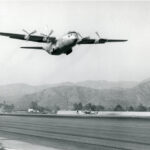With Captain George Vernon Holloman in the cockpit, and Captain Carl Joseph Crane and Mr. Raymond K. Stout in the cabin, a Fokker Y1C-14B, Army serial number 31-381, departed Wright Field and then automatically intercepted a series of four radio beacons, initiated a descent, and landed at nearby Patterson Field and braked to a stop, all without any input from the pilot. The two military officers were each awarded the Distinguished Flying Cross and the Mackay Trophy.
Captain Holloman’s citation read: “The President of the United States of America, authorized by Act of Congress, July 2, 1926, takes pleasure in presenting the Distinguished Flying Cross to Captain (Air Corps) George V. Holloman, U.S. Army Air Corps, for extraordinary achievement while participating in aerial flights in connection with the design and development of the airplane automatic landing system which made possible the first complete automatic airplane landing in history. Over the period of two years during which this system was under development, Captain Holloman, with utter disregard for his personal safety, performed virtually all of the great amount of flight testing which was required for the numerous items of equipment that go to make up the complete automatic landing assembly, and then finally on 23 August 1937, the first experimental automatic landing flights were made, he was in the cockpit of the airplane used for this purpose. The engineering skill, judgment, and resourcefulness displayed by Captain Holloman, and his courage in performing hundreds of test flights with highly experimental equipment, contributed largely to the ultimate successful development of the automatic landing system.”
A contemporary aviation publication stated: “After two years of research and preparation daring pilots and engineers of the Army Air Corps in 1937 began to make automatic “blind” landings without any control from the occupants of the airplane or observers on the surface. On Monday, August 23, a day when the air was bumpy and the wind decidedly adverse, a big Army plane swung over the horizon near Wright Field, at Dayton, O., and glided straight down on the runway, rolling a few yards and then coming to a stop as if it had been at all times in the hands of an expert pilot. But nobody had anything to do with this landing; There were three men in the Army’s cargo plane, and they were the three experts who had developed the apparatus. Like true scientists they had gone up and come down on this test to see for themselves just how their creation would work.”
The automatic landing system used a barometric altimeter, a radio compass, and Sperry Autopilot. The pilot would fly the airplane to a predetermined altitude at a distance greater than 20 miles (32 kilometers) from the airfield. When the system was activated, the airplane automatically maintained this altitude and turned toward the outermost beacon (Turns of up to 180° were demonstrated).
As the airplane passed over each of the three outer beacons, the radio compass frequency would change to that of the next successive beacon, and the airplane homed in on it. Coupled with the altimeter, the system prevented the airplane from descending below the minimum altitude until it had passed the innermost beacon.
When passing over the innermost beacon, the engine was automatically throttled back to begin a controlled descent. It then set the throttle to maintain a preset rate of descent and glide slope angle until ground contact was made. Switches in the landing gear signaled the system to bring the engine to idle and apply the brakes. During testing, all landings occurred with a crosswind.
Fokker’s Y1C-14B derived from the company’s F-14 commercial transport. It was a single-engine parasol-wing monoplane with the conventional fixed landing gear. The airplane was flown by a single pilot in an open cockpit and could carry up to six passengers in its enclosed cabin. It was 43 feet, 3 inches (13.183 meters) long, with a wingspan of 59 feet, 0 inches (17,983 meters), and a height of 12 feet, 0 inches (3.658 meters). The airplane’s maximum takeoff weight was 7,341 pounds (3,330 kilograms).
The Y1C-14B differed from the C-14A with the installation of an air-cooled, 1,690.537-cubic-inch-displacement (27.703 liters) Pratt & Whitney R-1690-5 nine-cylinder radial engine. This engine was direct-drive and had a compression ratio of 5:1. Burning 73-octane gasoline, it was rated at 525 horsepower at 1,900 r.p.m. at Sea Level. The R-1690-5 was 3 feet, 8.78 inches (1.137 meters) long, 4 feet, 6.43 inches (1.383 meters) in diameter, and weighed 850 pounds (386 kilograms). This engine was sold commercially as the Pratt & Whitney Hornet A2.
The Y1C-14B had a cruise speed of 133 miles per hour (214 kilometers per hour) and a maximum speed of 150 miles per hour (241 kilometers per hour). The service ceiling was 14,300 feet (4,359 meters). Its range was 675 miles (1,086 kilometers).
While the experiments in 1937 were a brave new beginning, the technology did not mature for commercial airline use until the 1960s, when British European Airways (antecedent of today’s British Airways) began flying automatic landings with their Hawker Siddeley HS-121 Trident short (and later medium-range) passenger jet. Such events are commonplace today, but we owe that confidence to the ingenuity of scientists and the brave test pilots who verified their designs, often at great cost!






























